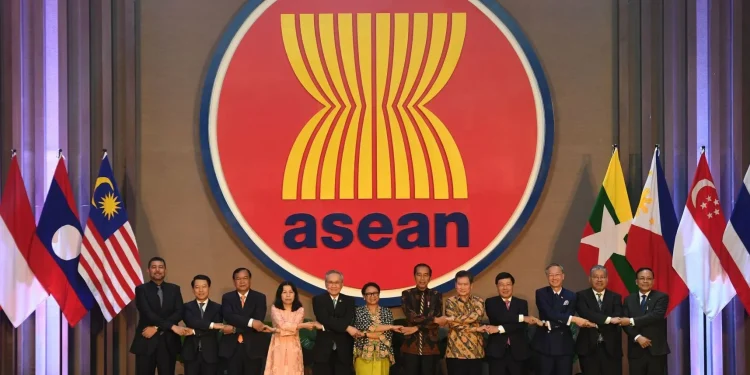
The dynamic landscape of economic relations between Southeast Asian nations and Korea is on the verge of significant transformation. As countries in this vibrant region seek to deepen their partnerships, an advanced framework is taking shape, promising exciting avenues for collaboration. This development signals a pivotal moment for stakeholders eager to explore new horizons.
With a focus on fostering interconnectedness, this initiative aims to create a more robust environment for exchanges across various sectors. Participants stand to gain from an expanded marketplace, enriched opportunities, and an innovative approach to ongoing challenges. Stakeholders are poised to leverage these transformations, driving growth and enhancing competitive advantages.
As the momentum builds, the potential for increased synergy becomes evident. Enhanced cooperation invites new ideas, cultivates resilience within economies, and strengthens ties among nations. This is not merely a negotiation process; it’s a collaborative journey that holds the promise of fruitful ventures and sustainable progress for all involved.
Understanding the Upgraded FTA Framework
Grasping the context of the enhanced collaborative economic structure requires an exploration of its underlying principles and proposed changes. The revised system aims to foster closer economic ties, streamline processes, and create a more dynamic environment for participants involved. By embracing innovations, the framework encourages growth, promotes regional stability, and strengthens partnerships across nations.
Key Components of the New Framework
-
Increased Market Access: The arrangement introduces more favorable conditions for businesses, facilitating smoother entry into diverse markets.
-
Tariff Reductions: Adjustments in tariffs help minimize costs for consumers and businesses alike, encouraging higher trade volumes.
-
Non-Tariff Measures: The revised structure addresses various non-tariff barriers, ensuring fair competition and enhancing operational efficiency.
-
Intellectual Property Protection: Strengthening these regulations fosters innovation by securing creators’ rights and encouraging investments in new ideas.
Implications for Stakeholders
-
Businesses: Companies can leverage new possibilities for expansion and diversification within the member states.
-
Governments: Administrations can promote favorable policies that support economic growth and enhance diplomatic relations.
-
Consumers: Individuals may experience increased choices and lower prices as competition intensifies.
Economic Impact on ASEAN Member States
The enhancement of economic relations between the regions heralds significant changes for member countries, fostering greater integration and collaboration while opening new avenues for growth. This transformation is set to create a ripple effect across various sectors, invigorating economies and enhancing competitive positioning in the global marketplace.
-
Increased Exports: Nations can expect a surge in their export volumes as barriers are lowered, allowing for smoother access to regional markets.
-
Investment Opportunities: A more interconnected framework will attract foreign investments, catalyzing infrastructure development and technological advancements.
-
Job Creation: The resulting economic activities are likely to lead to the creation of numerous job opportunities, contributing to higher employment rates.
-
Diverse Product Offerings: Enhanced interactions will promote a wider variety of goods and services in the markets, benefiting consumers through increased choices.
-
Strengthened Economic Resilience: By fostering a collaborative environment, member states can build resilience against external shocks and economic fluctuations.
In conclusion, these developments hold the promise of a robust economic landscape, elevating the standard of living and pushing the region toward a prosperous future.
New Trade Opportunities for Korean Enterprises
The evolving landscape of international commerce offers exciting prospects for Korean companies aiming to expand their reach. As markets integrate and evolve, businesses can find themselves positioned to leverage new pathways for growth and cooperation. The recent emphasis on fostering connections with Southeast Asian countries has opened doors for innovative collaboration that can significantly enhance economic interactions.
Korean enterprises stand to gain from an increasingly favorable environment that encourages investment and joint ventures. The alignment of interests between nations can lead to fruitful partnerships, where technology, resources, and skills are exchanged, fostering mutual development. Furthermore, this shift could lead to increased market access, allowing Korean businesses to introduce their products and services to a wider audience.
Moreover, various sectors, including technology, healthcare, and renewable energy, are ripe with potential for Korean firms to explore. The demand for advanced solutions in these areas continues to grow within Southeast Asia, presenting prime opportunities for companies ready to innovate and collaborate. By tapping into local needs and preferences, enterprises can optimize their offerings, ensuring relevance and competitiveness in these vibrant markets.
Additionally, with an enhanced focus on infrastructure and digital transformation across the region, Korean businesses may find niche opportunities in development projects, ranging from smart city initiatives to e-commerce platforms. Engaging with local stakeholders will be crucial in understanding challenges and customs, thereby paving the way for successful endeavors.
As these new ventures unfold, Korean enterprises are encouraged to stay agile and proactive, preparing to respond to the dynamic nature of the marketplace. The potential rewards are significant, providing a unique chance to influence the economic landscape while achieving substantial growth.
Investment Prospects in Emerging Markets
The landscape of global finance is witnessing a transformative phase, where previously untapped regions are becoming increasingly appealing to investors. This shift is fueled by evolving economic conditions, technological advancements, and the growing demand for diversified portfolios. Investors are now identifying these dynamic markets as fertile ground for substantial growth and robust returns.
Key Factors Driving Investment
-
Economic Growth: Many of these regions are experiencing rapid economic expansion. Increased consumer spending and urbanization contribute significantly to this growth.
-
Demographic Trends: A burgeoning middle class, coupled with a young population, creates a vibrant consumer base, enhancing business opportunities.
-
Policy Reforms: Governments are implementing favorable policies that encourage foreign investments, simplifying regulatory frameworks.
-
Technological Innovation: Advancements in technology facilitate new business models and enhance productivity, making these markets more attractive.
Strategic Sectors for Investment
-
Infrastructure: Investments in transportation, energy, and telecommunications are crucial for supporting the growth of emerging economies.
-
Healthcare: With rising populations, the demand for healthcare services and products is on the rise, making this sector a promising area for investment.
-
Renewable Energy: As sustainability becomes paramount, investments in clean energy are significantly increasing.
-
Technology and E-Commerce: The digital transformation offers lucrative opportunities in tech startups and online commerce.
In summary, the potential for capital influx into these evolving markets is significant. Investors looking to expand their horizons should carefully analyze the unique opportunities presented by each region while considering the associated risks and challenges.
Strategic Collaborations in Technology Transfer
In the dynamic landscape of innovation, partnerships play a crucial role in facilitating the exchange of knowledge and expertise among nations. These alliances can accelerate the adaptation and implementation of cutting-edge technologies, fostering a robust environment for growth and development. By leveraging the strengths of different actors, societies can harness transformative solutions that address pressing challenges and enhance economic resilience.
Enhancing Research and Development Efforts
Collaborative initiatives in the field of research and development can significantly enhance the capacity of nations to innovate. By pooling resources, sharing facilities, and conducting joint projects, stakeholders can capitalize on each other’s strengths, leading to breakthroughs in various industries. This synergy not only promotes technological advancements but also nurtures a culture of creativity and problem-solving.
Building Sustainable Ecosystems
Strategic partnerships in technology transfer also contribute to the establishment of sustainable ecosystems that support long-term growth. By focusing on knowledge-sharing frameworks and training programs, countries can develop a skilled workforce equipped to navigate the complexities of modern technologies. Such ecosystems promote continuous learning and adaptation, ensuring that nations remain competitive in the ever-evolving global market.
Challenges Facing Trade Relations Ahead
As nations enhance their economic connections, they must navigate a myriad of obstacles that could hinder cooperation. These challenges often stem from differing regulations, market dynamics, and external geopolitical factors. Addressing these issues requires comprehensive strategies and collaborative efforts from all involved parties to ensure a harmonious economic landscape.
Regulatory and Compliance Hurdles
Diverse legal frameworks among countries can lead to misunderstandings and compliance difficulties. Variations in standards, tariffs, and import/export regulations may create barriers for businesses seeking to expand into new markets. Streamlining procedures and establishing mutual recognition of regulations can facilitate a smoother transition for enterprises looking to engage in cross-border commerce.
Geopolitical Tensions and Economic Stability
Geopolitical tensions can complicate economic interactions, impacting investor confidence and market stability. Fluctuating diplomatic relations may result in uncertainty, leading to hesitance from stakeholders to engage in long-term commitments. Maintaining open channels of communication and fostering dialogue among nations can help alleviate tensions and encourage a more predictable environment for economic activities.
Q&A: Upgraded aseankorea free trade agreement in pipeline
What are the key benefits of the upgraded ASEAN-Korea Free Trade Agreement?
The upgraded ASEAN-Korea Free Trade Agreement (AKFTA) is expected to bring several key benefits, including reduced tariffs on goods, enhanced trade facilitation measures, and increased market access for various industries. This will lower costs for businesses and consumers, promote economic growth in member countries, and strengthen integration among ASEAN and South Korean economies. Additionally, the agreement aims to address non-tariff barriers and facilitate smoother trade by streamlining customs procedures, which can significantly enhance trade efficiency.
How will small and medium-sized enterprises (SMEs) benefit from the upgraded AKFTA?
Small and medium-sized enterprises (SMEs) stand to gain significantly from the upgraded AKFTA as it will provide them with greater access to regional markets without the same level of competitive disadvantages faced by larger corporations. The agreement includes provisions aimed at supporting SMEs through capacity-building initiatives, promoting technology transfer, and enhancing access to financing. Furthermore, with reduced tariffs and simplified export processes, SMEs can explore new business opportunities and potentially reach a wider customer base in both ASEAN member states and Korea.
What challenges might arise from the upgraded AKFTA implementation?
While the upgraded AKFTA presents many opportunities, there are also several challenges that may arise during its implementation. Countries may face difficulties in harmonizing regulations and standards, which can create trade friction if not properly addressed. Additionally, sectors that are less competitive might struggle with increased competition from imports, potentially leading to job losses. Ensuring effective communication and collaboration among member states will be crucial to overcoming these challenges, as well as providing support for industries that may need assistance to adapt to the new trade landscape.
What specific sectors are likely to benefit the most from the upgraded AKFTA?
Several sectors are poised to benefit significantly from the upgraded AKFTA, including electronics, automotive, agriculture, and services. The electronics sector, for instance, can expect enhanced cooperation and supply chain integration, making it easier to export components across borders. In agriculture, reduced tariffs on products will boost exports of agricultural goods like rice, fruits, and seafood. Furthermore, the services sector, particularly in areas like information technology and tourism, may see increased engagement as the agreement facilitates the free flow of professionals and strengthens intra-regional connectivity.
What opportunities does the upgraded AKFTA provide for foreign investors?
The upgraded ASEAN-Korea Free Trade Agreement provides a range of opportunities for foreign investors looking to tap into the ASEAN and South Korean markets. As tariffs are reduced and investment barriers are lowered, investors can expect a more favorable business environment. Additionally, the agreement’s emphasis on transparency and regulatory cooperation can reduce risks associated with doing business in the region. Foreign investors can also capitalize on the growing consumer markets in ASEAN countries, increased infrastructure development, and the shifting of global supply chains to the region, all of which are attractive elements for sustained investment growth.
What is the current status of the Economic Partnership Agreement between ASEAN and South Korea?
The Economic Partnership Agreement between ASEAN and South Korea is currently in the process of upgrading its existing free trade agreement. This process aims to enhance bilateral trade and investment, reflecting both parties’ commitment to deepening their economic cooperation. The upgrade is part of a broader strategy to improve economic ties and address evolving trade and investment needs.
How does the upgrading of the Economic Partnership Agreement impact trade between ASEAN and South Korea?
Upgrading the existing Economic Partnership Agreement is expected to have a significant impact on trade between ASEAN and South Korea. The new agreement will likely enhance trade and investment opportunities by introducing updated provisions and preferential trade terms. This move aims to boost bilateral trade, streamline market access, and foster greater economic integration between the two regions.
What role does the Regional Comprehensive Economic Partnership (RCEP) play in the context of ASEAN and South Korea’s economic relations?
The Regional Comprehensive Economic Partnership (RCEP) plays a crucial role in the context of ASEAN and South Korea’s economic relations by providing a comprehensive framework for trade and investment across the Asia-Pacific region. As a signatory of RCEP, South Korea benefits from its economic partnership with ASEAN member states, facilitating trade and investment flows and supporting regional economic integration.
How are ASEAN and South Korea addressing foreign direct investment through their economic agreements?
ASEAN and South Korea are addressing foreign direct investment (FDI) through their economic agreements by negotiating terms that promote greater investment flows between the regions. The upgraded Economic Partnership Agreement is expected to include provisions that enhance investment opportunities, provide better protection for investors, and encourage more significant FDI inflows into both ASEAN and South Korea.
What are some of the key areas of focus for the economic cooperation between ASEAN and South Korea in the upgraded agreement?
The upgraded Economic Partnership Agreement between ASEAN and South Korea will focus on several key areas, including improving trade and investment conditions, enhancing market access, and fostering economic integration. Specific areas of focus include addressing rules of origin, streamlining customs procedures, and promoting collaboration on innovation and low-carbon technologies. These enhancements aim to support both bilateral trade and broader regional economic integration.




